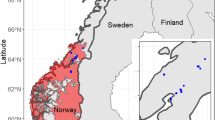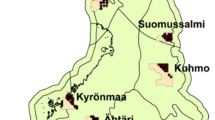Abstract
Efficient identification of forest age is useful for forest management and ecological applications. Here we propose a user-assisted method for determining forest age using high spatial resolution remotely sensed imagery. This method requires individual trees to be extracted from imagery and represented as points. We use a local maximum filter to generate points that are converted to Voronoi polygons. Properties of the Voronoi polygons are correlated with forest age and used to aggregate points (trees) into areas (stands) based on three forest age classes. Accuracy of the aggregation ranges from approximately 68% to 78% and identification of the mature class is more consistent and accurate than the younger classes.
Similar content being viewed by others
References
D. Brown. “Classification and boundary vagueness in mapping presettlement forest types,” International Journal of Geographical Information Science, Vol. 12:105-129, 1998.
G. Frazer, J. Troyfymow, and K. Lertzman. “Canopy openness and leaf area in chronosequences of coastal temperate rainforests,” Canadian Journal of Forest Research, Vol. 30:239-256, 2000.
M. Gillis and D. Leckie. “Forest inventory mapping procedures across Canada,” PNFI, Ontario, Canada. Information Report. PI-X-114, 79, 1993.
GVWD. “Greater Victoria water district watershed management forest cover classification,” Sooke Lake Watershed, Hugh Hamilton Ltd., Victoria. Scale 1:15000, 1991.
F. He and R. Duncan. “Density-dependent effects of tree survival in an old-growth Douglas fir forests,” Journal of Ecology, Vol. 88:676-688, 2000.
S. Larsson, R. Oren, R. Waring, and J. Barrett. “Attacks of mountain pine beetle as related to tree vigor of ponderosa pine,” Forest Science, Vol. 29:395-402, 1983.
K. Lertzman, G. Sutherland, A. Inselberg, and S. Saunders. “Canopy gaps and the landscape mosaic in a costal temperate rainforest,” Ecology, Vol. 77:1254-1270, 1996.
R. Mitchell and H. Preisler. “Analysis of spatial patterns of lodegepole pine attacked by outbreak populations of the mountain pine beetle,” Forest Science, Vol. 37:1390-1408, 1991.
T. Nelson, O. Niemann, and M. Wulder. “Spatial statistical techniques for aggregating point objects extracted from high spatial resolution imagery,” Journal of Geographical Systems, Vol. 4:423-433, 2002.
A. Okabe, B. Boots, K. Sugihara, and S. Chiu. Spatial Tessellations: Concepts and Applications of Voronoi Diagrams, Second Edition, John Wiley: Chichester, 2000.
C. Oliver and B. Larson. Forest Stand Dynamics. John Wiley & Sons: New York, 1996.
T. Spies and J. Franklin. “Gap characteristics and vegetation response in coniferous forests of the Pacific Northwest,” Ecology, Vol: 70:543-545, 1989.
M. Wulder, O. Niemann, and D. Goodenough. “Local maximum filtering for the extraction of tree locations and basal area from high spatial resolution imagery,” Remote Sensing of Environment, Vol. 73:103-114, 2000.
Author information
Authors and Affiliations
Rights and permissions
About this article
Cite this article
Nelson, T., Boots, B., Wulder, M. et al. Predicting Forest Age Classes from High Spatial Resolution Remotely Sensed Imagery Using Voronoi Polygon Aggregation. GeoInformatica 8, 143–155 (2004). https://doi.org/10.1023/B:GEIN.0000017745.92969.31
Issue Date:
DOI: https://doi.org/10.1023/B:GEIN.0000017745.92969.31




